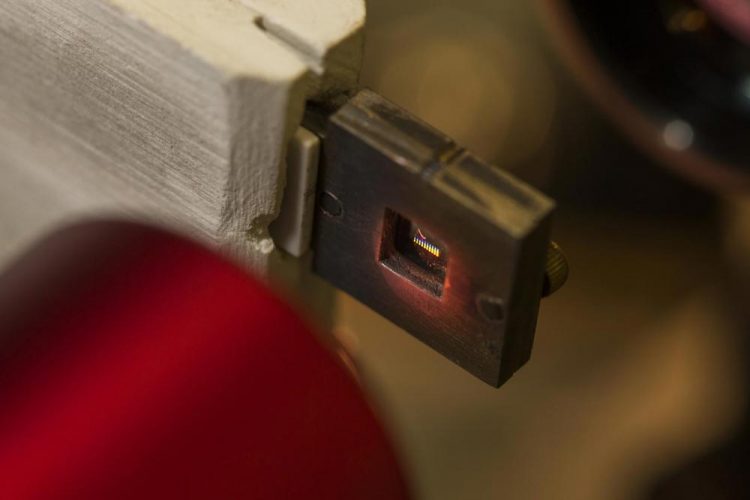ANU invention may help to protect astronauts from radiation in space

The sample here contains hundreds of thousands of nanoparticles that manipulate the incoming light. Credit: Stuart Hay, ANU
Lead researcher Dr Mohsen Rahmani from ANU said the material was so thin that hundreds of layers could fit on the tip of a needle and could be applied to any surface, including spacesuits.
“Our invention has a lot of potential applications, such as protecting astronauts or satellites with an ultra-thin film that can be adjusted to reflect various dangerous ultraviolet or infrared radiation in different environments,” said Dr Rahmani, an Australian Research Council (ARC) Discovery Early Career Research Fellow at the Nonlinear Physics Centre within the ANU Research School of Physics and Engineering.
“Our technology significantly increases the resistance threshold against harmful radiation compared to today's technologies, which rely on absorbing radiation with thick filters.”
Co-researcher Associate Professor Andrey Miroshnichenko said the invention could be tailored for other light spectrums including visible light, which opened up a whole array of innovations, including architectural and energy saving applications.
“For instance, you could have a window that can turn into a mirror in a bathroom on demand, or control the amount of light passing through your house windows in different seasons,” said Dr Miroshnichenko from the Nonlinear Physics Centre within the ANU Research School of Physics and Engineering.
“What I love about this invention is that the design involved different research disciplines including physics, materials science and engineering.”
Co-lead researcher Dr Lei Xu said achieving cost-efficient and confined temperature control such as local heating was feasible.
“Much like your car has a series of parallel resistive wires on the back windscreen to defog the rear view, a similar arrangement could be used with our invention to confine the temperature control to a precise location,” said Dr Xu from the Nonlinear Physics Centre within the ANU Research School of Physics and Engineering.
The innovation builds on more than 15 years of research supported by the ARC through CUDOS, a Centre of Excellence, and the Australian National Fabrication Facility.
The research is published in Advanced Functional Materials.
###
Watch a video interview with the researchers on the ANU YouTube channel: youtu.be/cpXRifjaKhk
FOR INTERVIEW:
Dr Mohsen Rahmani
ANU Research School of Physics and Engineering
M: +61 435 086 036
E: mohsen.rahmani@anu.edu.au
Associate Professor Andrey Miroshnichenko
ANU Research School of Physics and Engineering
T: +61 2 6125 3964
E: andrey.miroshnichenko@anu.edu.au
Dr Lei Xu
ANU Research School of Physics and Engineering
T: +61 2 6125 9203
E: lei.xu@anu.edu.au
FOR MEDIA ASSISTANCE:
Will Wright
ANU media team
T: +61 2 6125 7979
M: +61 478 337 740
E: media@anu.edu.au
Media Contact
All latest news from the category: Physics and Astronomy
This area deals with the fundamental laws and building blocks of nature and how they interact, the properties and the behavior of matter, and research into space and time and their structures.
innovations-report provides in-depth reports and articles on subjects such as astrophysics, laser technologies, nuclear, quantum, particle and solid-state physics, nanotechnologies, planetary research and findings (Mars, Venus) and developments related to the Hubble Telescope.
Newest articles

Superradiant atoms could push the boundaries of how precisely time can be measured
Superradiant atoms can help us measure time more precisely than ever. In a new study, researchers from the University of Copenhagen present a new method for measuring the time interval,…

Ion thermoelectric conversion devices for near room temperature
The electrode sheet of the thermoelectric device consists of ionic hydrogel, which is sandwiched between the electrodes to form, and the Prussian blue on the electrode undergoes a redox reaction…

Zap Energy achieves 37-million-degree temperatures in a compact device
New publication reports record electron temperatures for a small-scale, sheared-flow-stabilized Z-pinch fusion device. In the nine decades since humans first produced fusion reactions, only a few fusion technologies have demonstrated…





















